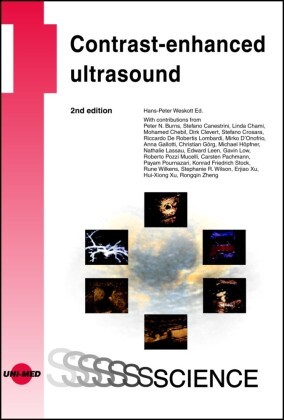
Contrast-enhanced ultrasound
| Verlag | Uni-Med |
| Auflage | 2013 |
| Seiten | 240 |
| Format | 17,6 x 24,6 x 1,5 cm |
| Gewicht | 584 g |
| Artikeltyp | Englisches Buch |
| Reihe | UNI-MED Science |
| ISBN-10 | 3837414280 |
| EAN | 9783837414288 |
| Bestell-Nr | 83741428A |
The benefit in using Contrast-Enhanced Ultrasound (CEUS) has been proven over many years, not only for liver disease but also for a range of extra-hepatic indications. Liver guidelines have now also been updated on a larger international scale by a team from Europe as well as by experts from Asia and the USA. This book should help not just towards a start into a new and exciting imaging world, but also to support those who already perform CEUS on a daily basis.
Inhaltsverzeichnis:
1.Basics161.1.Bubbles and how ultrasound systems talk to them161.1.1.Contrast agents for ultrasound171.1.1.1.Blood pool agents171.1.1.2.Selective uptake agents181.1.2.Talking to bubbles: physical principles of contrast imaging191.1.2.1.Bubble behavior and incident pressure191.1.2.2.The Mechanical Index (MI)191.1.2.3.Nonlinear echoes and harmonic imaging201.1.2.4.Harmonic B-mode imaging211.1.2.5.Pulse inversion imaging211.1.2.6.Pulse inversion Doppler imaging: amplitude and phase modulation221.1.2.7.Temporal Maximum Intensity Projection (MIP) imaging231.1.2.8.Disrupting bubbles: intermittent imaging231.2.Safety considerations and regulatory status261.3.Clinical aspects of adverse reactions281.4.B-mode ultrasound documentation291.4.1.Contrast-enhanced ultrasound (CEUS) documentation291.4.2.Basics of CEUS documentation301.4.3.CEUS documentation: Characterization of a focal liver lesion301.4.4.Detection of malignant liver lesions311.4.5.Systematic documentation of the liver: standardi zed sweeps321.4.6.Non-liver CEUS documentation321.5.CEUS and volume navigation / fusion imaging321.5.1.V-NAV - Technical background321.5.2.How to use V-Nav321.5.2.1.Marking331.5.2.2.Fusion Imaging341.5.2.3.Other clinical purposes361.6.Examination strategies, tips & techniques361.6.1.Prior to a CEUS study361.6.2.Reasons for an insufficient contrast enhancement391.6.3.Dosage of contrast agent411.6.4.Acoustic output (MI) and bubble destruction421.6.5.Probe types and contrast imaging431.6.6.CEUS performance442.Liver492.1.Kinetics of US contrast agents492.2.Benign focal liver lesions502.2.1.Benign cystic liver lesions512.2.2.Focal fatty infiltration512.2.3.Hemangioma522.2.4.Focal nodular hyperplasia532.2.5.Hepatic adenoma542.2.6.Rare benign focal liver lesions572.3.Infectious diseases592.3.1.Liver infections592.3.2.Liver abscesses592.3.2.1.Parasitic focal liver diseases612.3.3.Other Infections622.4.Hepatocellular carcinoma662.4.1.Characterization of HCC by CEUS672.4.2.Detection of HCC by CEUS712.4.3.Diagnostic work-up for HCC based on ultrasound and CEUS712.5.Cholangiocarcinoma722.6.Detection of focal liver lesions762.7.Differentiation between benign and malignant liver lesions802.8.Evaluation and characterization of metastatic liver disease862.8.1.Vascular involvement882.9.The role of contrast enhanced ultrasound in liver surgery962.9.1.Background962.9.2.Contrast-enhanced intraoperative ultrasound (CE-IOUS) technique982.9.3.Characterization of focal liver lesions with CE-IOUS992.9.4.CE-IOUS of liver metastases1002.9.5.Actual change in surgical mangement as a result of CE-IOUS1002.9.6.Clinical perspective1012.9.7.CE-IOUS of HCC1022.9.8.Limitations of CE-IOUS1032.9.9.Future directions and challenges1042.10.CEUS in the follow-up after liver transplantation1062.10.1.Vascular complications1072.10.1.1.Hepatic artery1072.10.1.2.Portal vein1082.10.1.3.Inferior vena cava (IVC) and hepatic vein1092.11.Evaluation of anti-angiogenic treatments using dynamic contrast-enhan ced ultrasonography with quantification1102.11.1.Post processing1112.11.2.Further evaluation of DCE-US1123.Gallbladder diseases1213.1.Cholecystitis and complications1213.2.Malignant tumors of the gallbladder wall1254.Pancreas1284.1.Pancreatic vasculature and parenchymal enhancement1284.2.Comparison to other imaging modalities1294.3.Examination technique1304.4.Inflammatory diseases1314.5.Cystic pancreatic tumors1324.6.Solid pancreatic tumors1335.Spleen1405.1.Splenic vasculature and parenchymal enhancement1405.2.Examination technique1405.3.Diffuse splenic diseases1415.4.Vascular splenic lesions1435.5.Benign focal lesions1445.6.Secundary malignant focal splenic lesions1496.Kidneys and collective system1526.1.Infectious diseases1526.2.Solid renal tumors1566.2.1.Benign renal tumors1596.2.1.1.Angiomyolipoma1596.2.1.2.Oncocytoma1626.2.2.Malignant renal tumors1646.3.Cystic renal tumors1706.3.1.Urothelium ca
